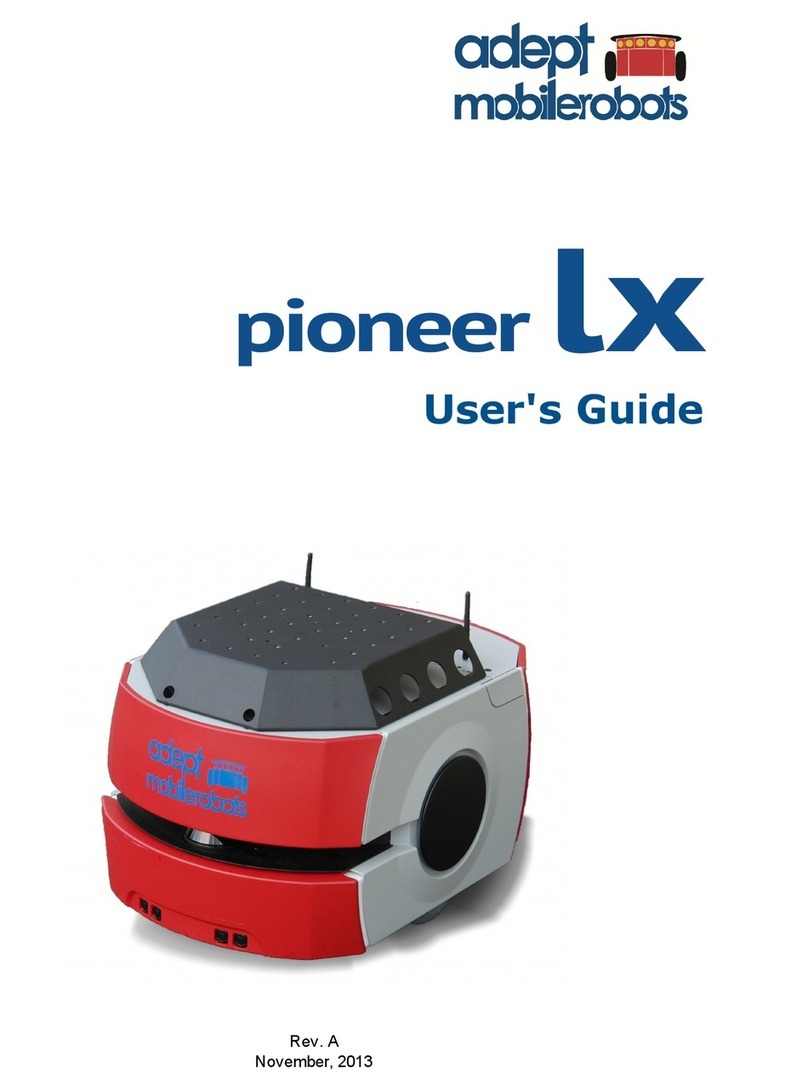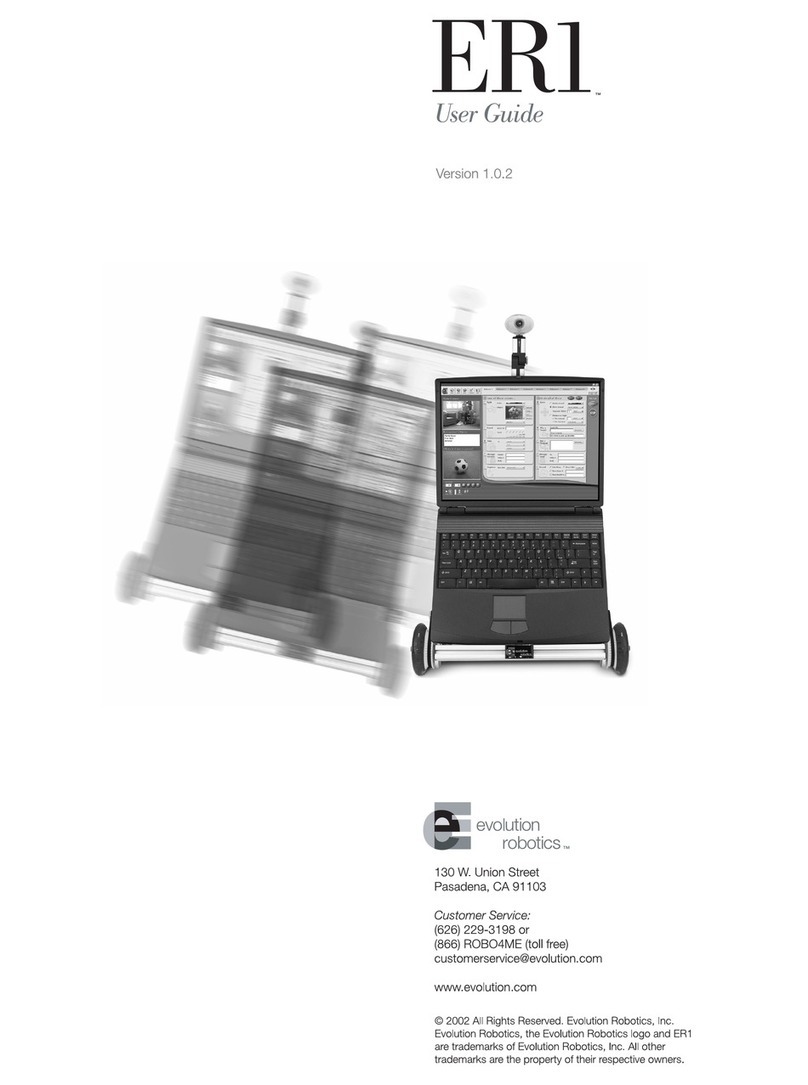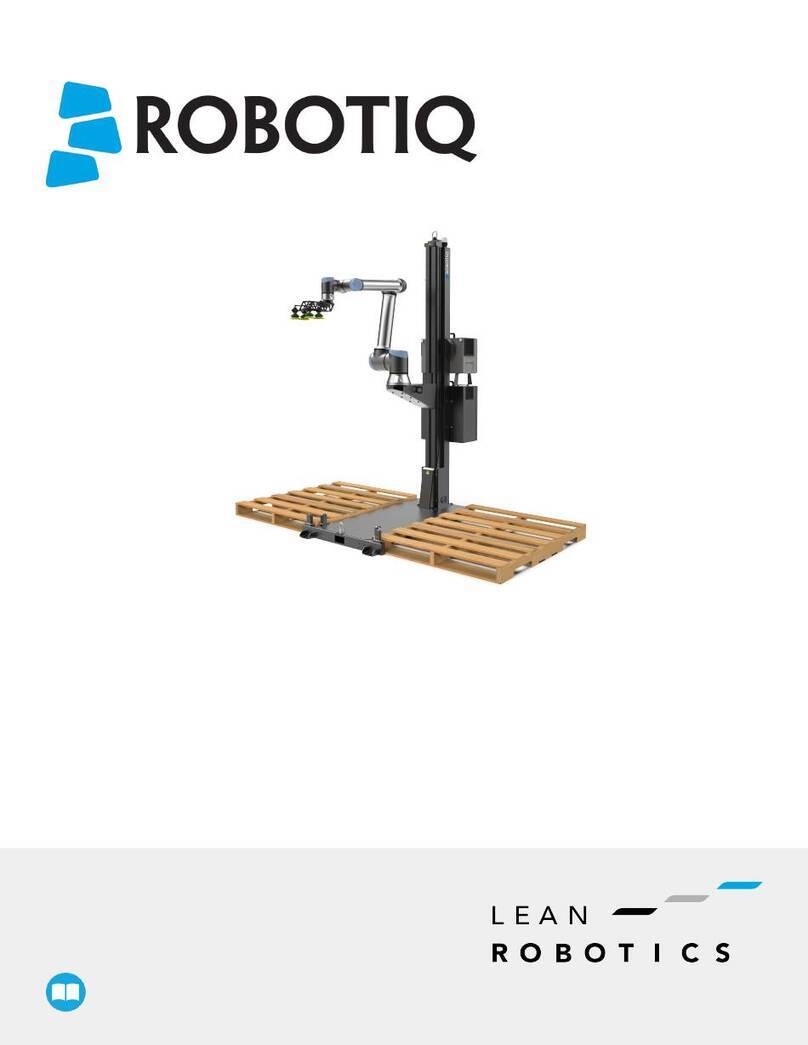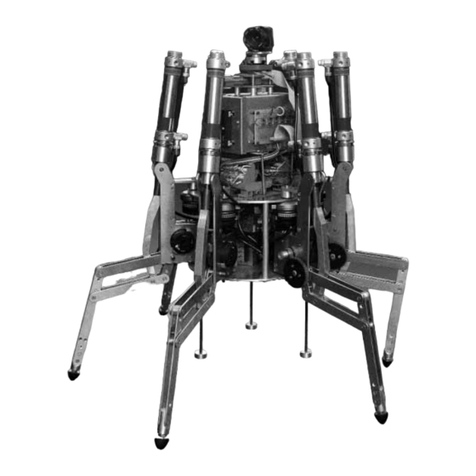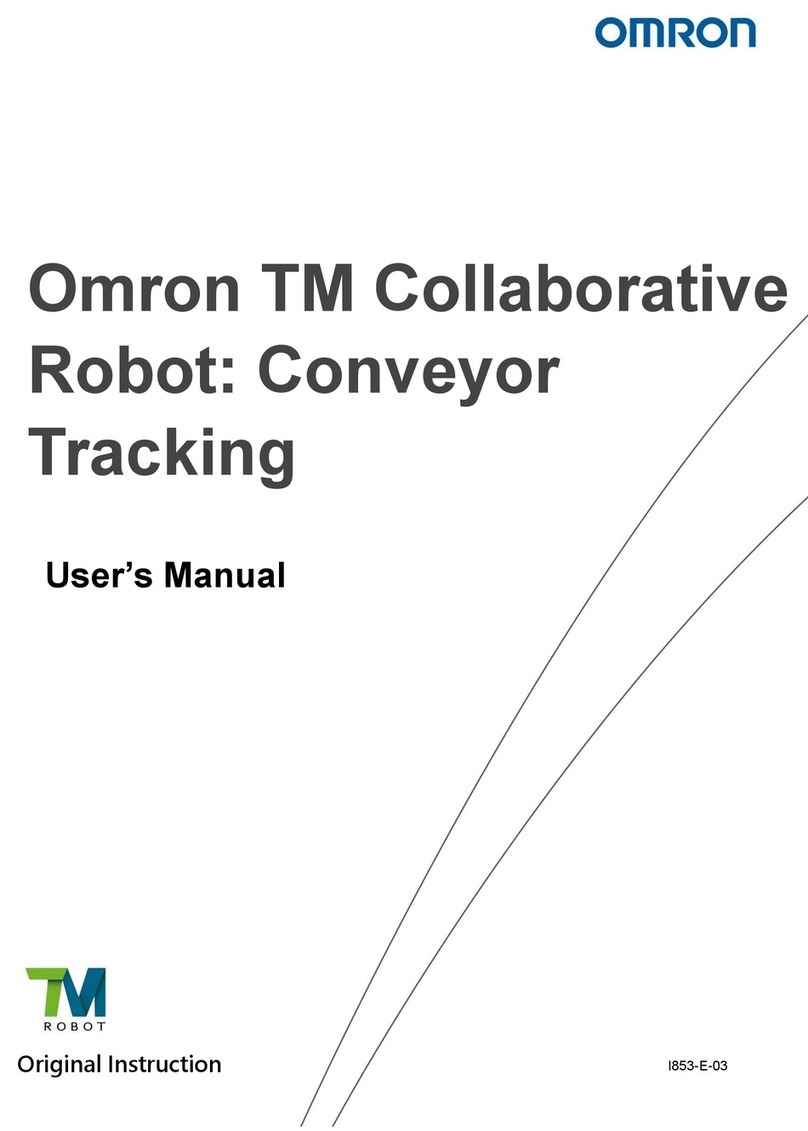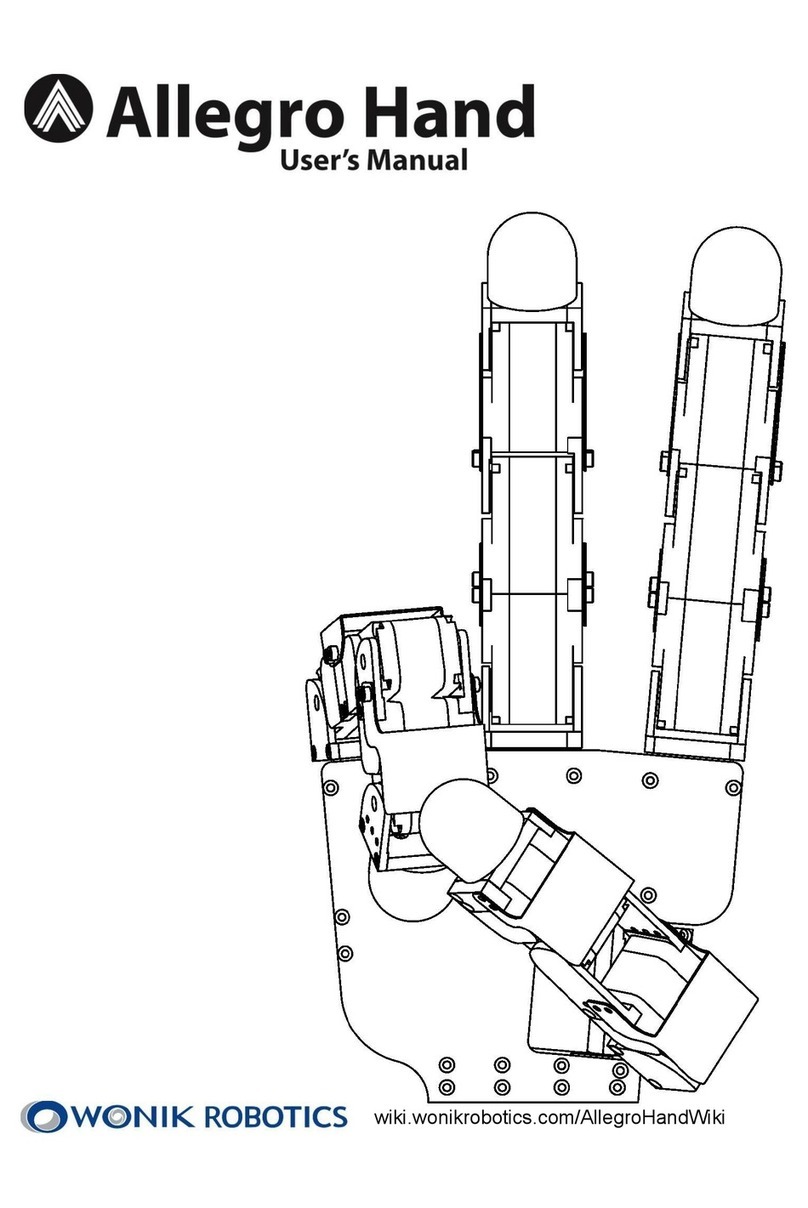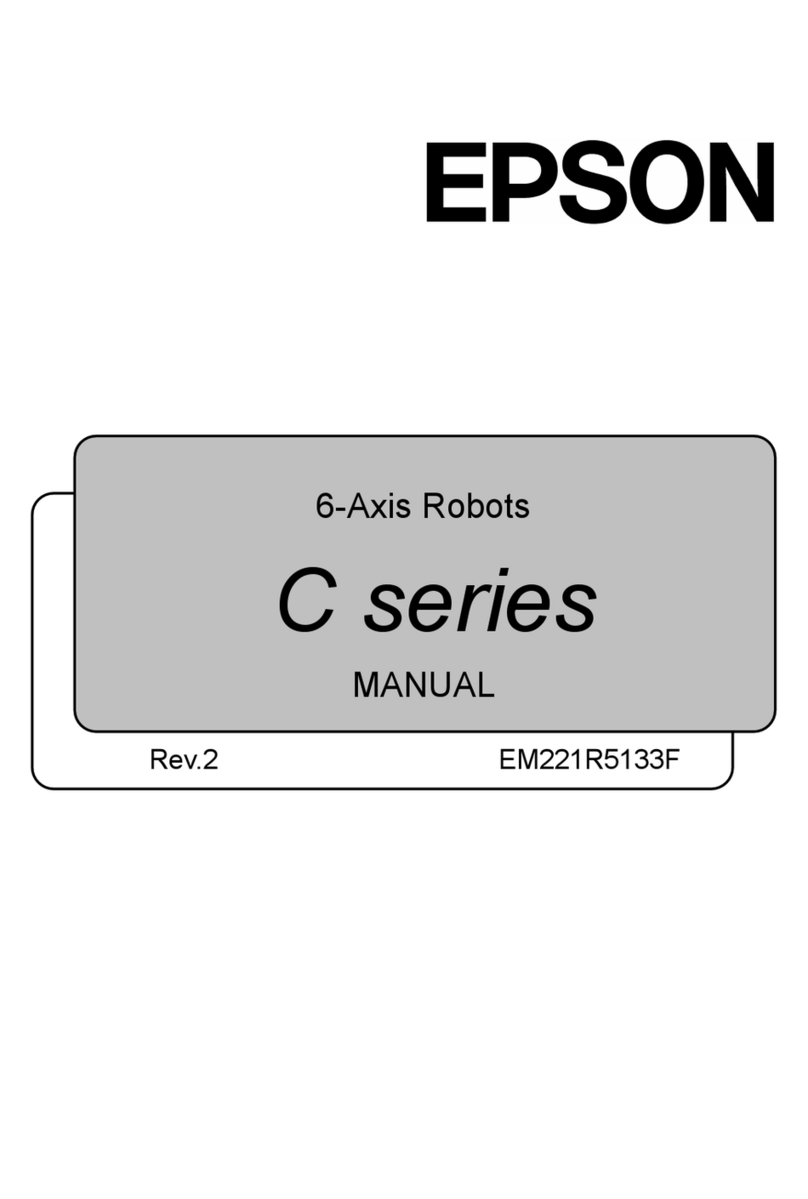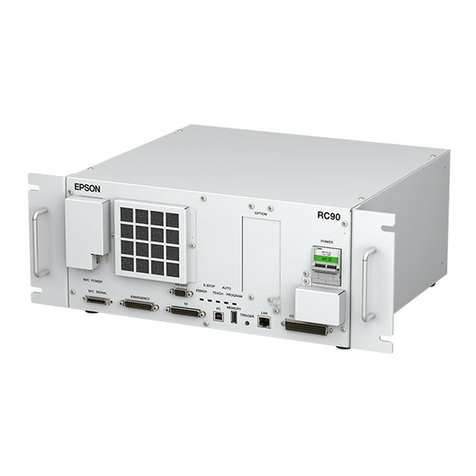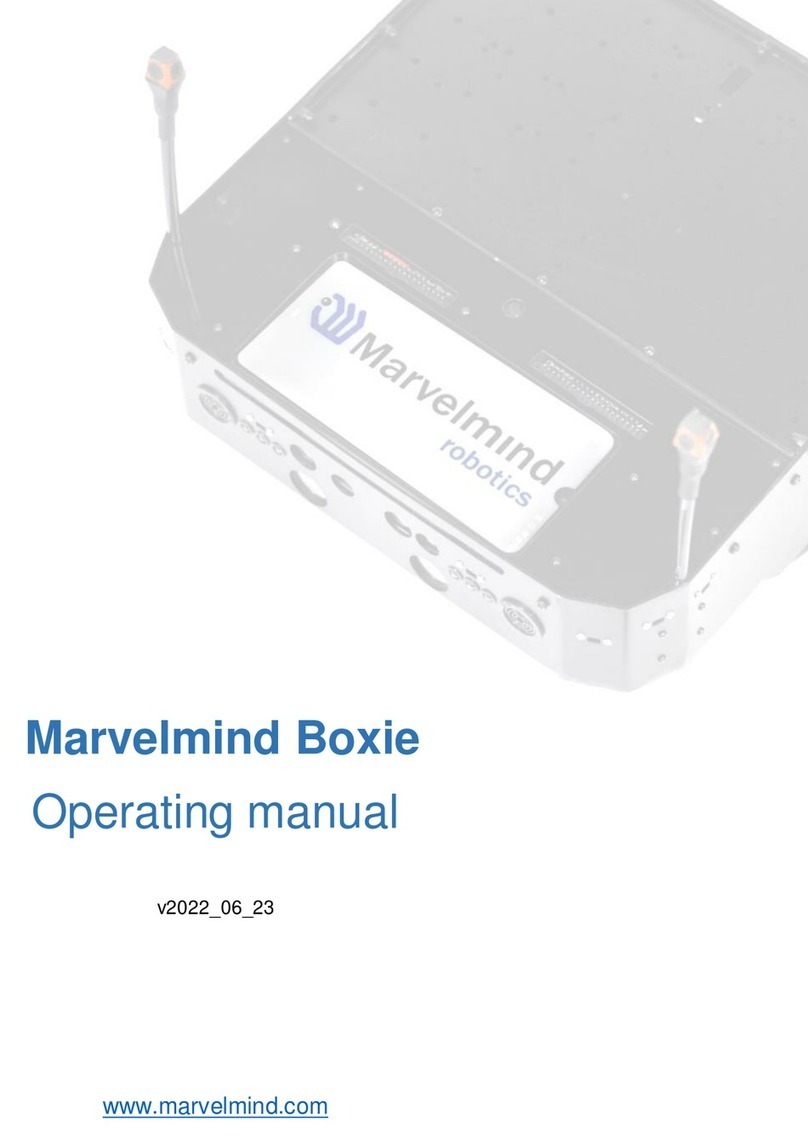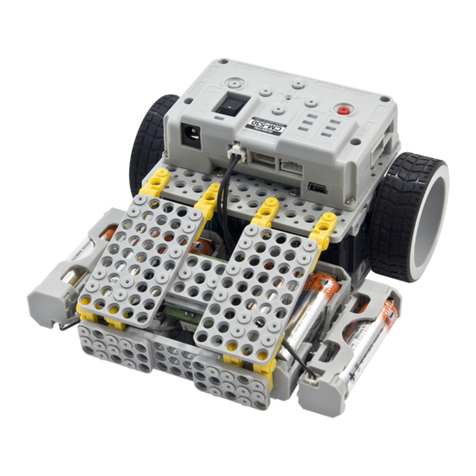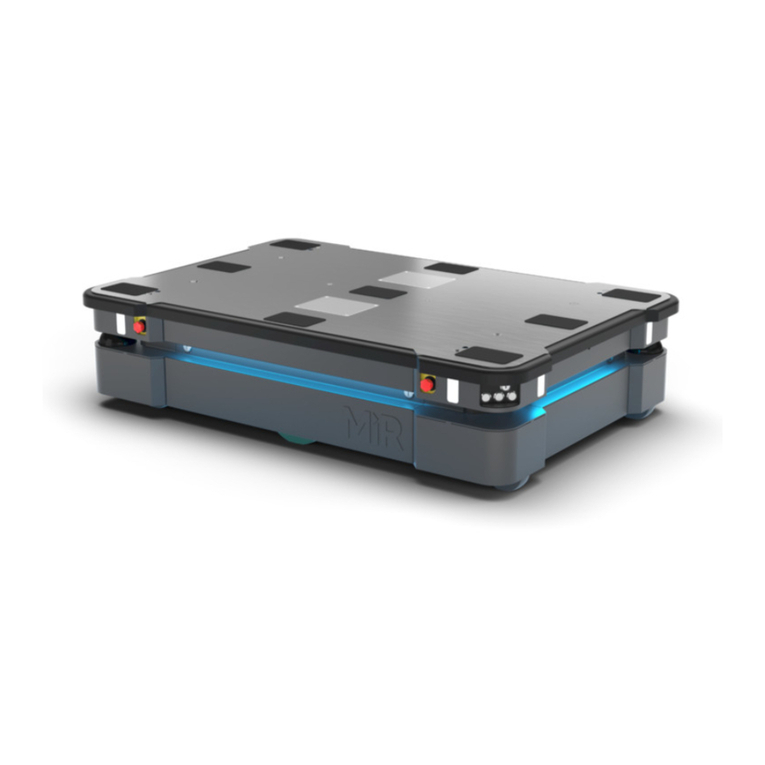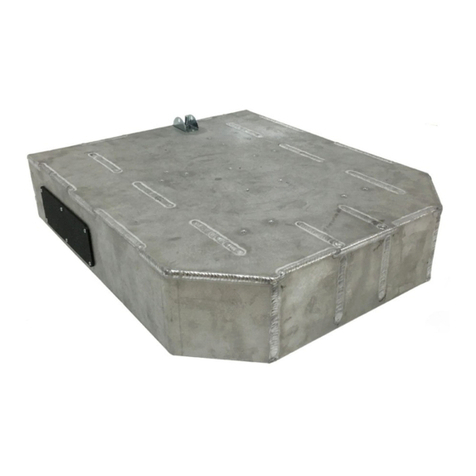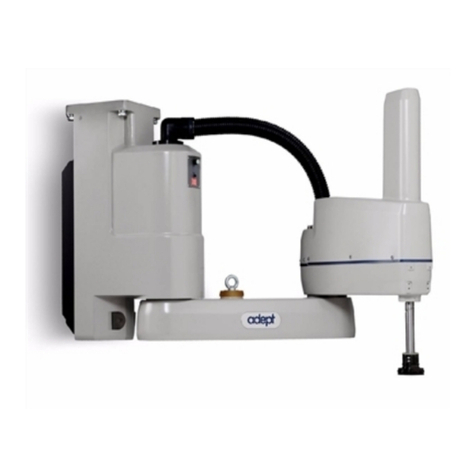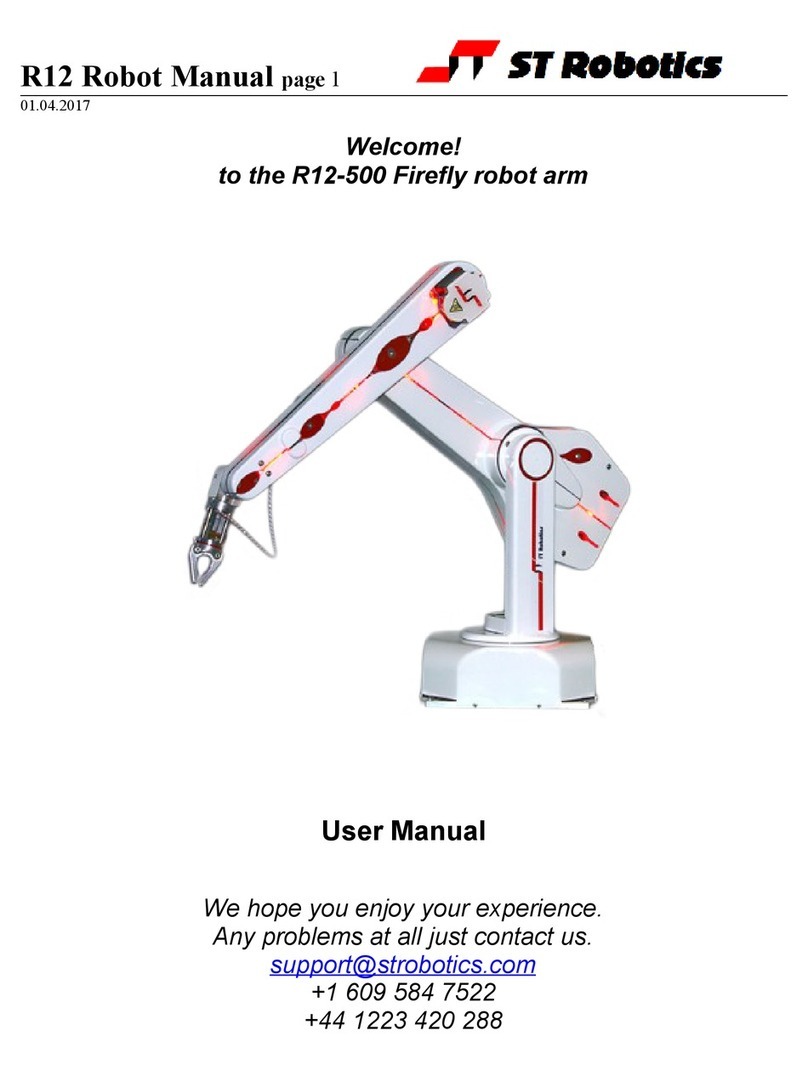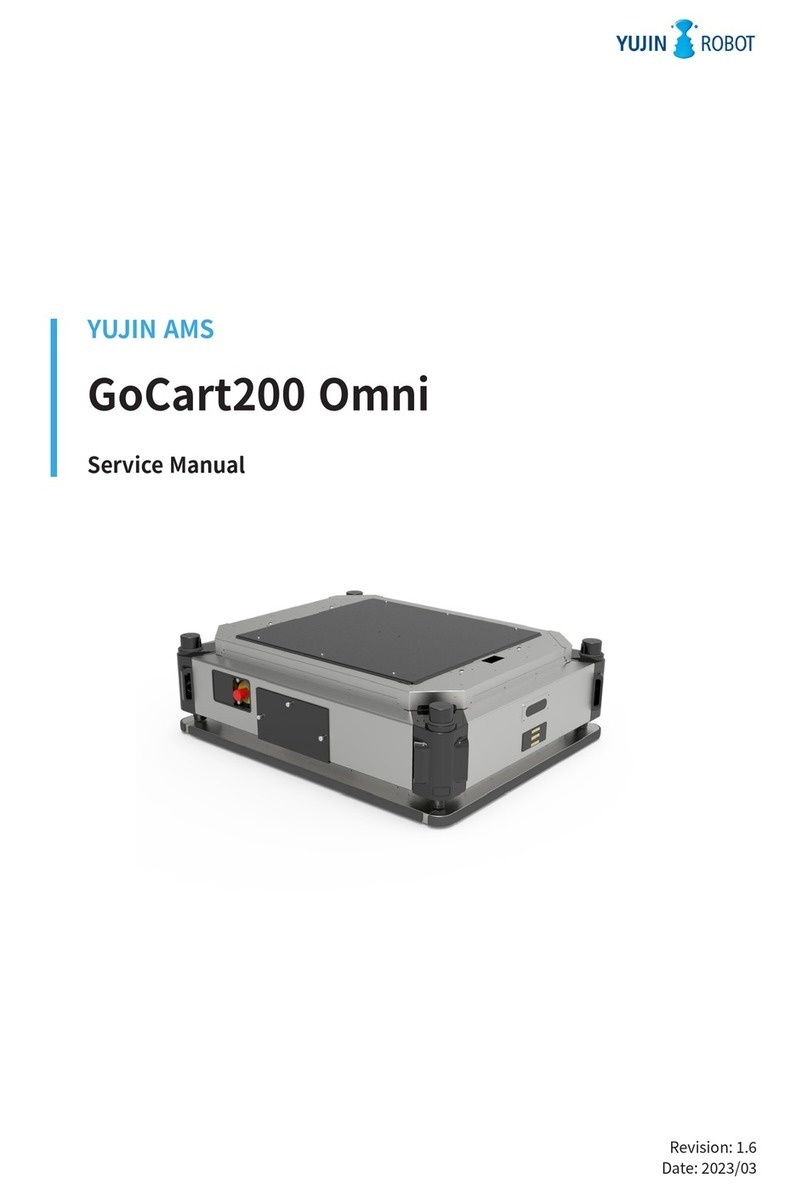Robodyssey Roach User manual

Robodyssey Roach
Assembly Instructions
Version 1.03 - Modied 7/31/2002
Robodyssey Systems, LLC. Phone/Fax: 609-585-8535
20 Quimby Avenue Web: www.robodyssey.com
Trenton, New Jersey 08610 Email: info@robodyssey.com

Copyright 2002 Robodyssey Systems, LLC. All rights reserved.
Basic Express and BasicX are trademarks of NetMedia, Inc.
Basic Stamp is a trademark of Parallax, Inc.

1 Introduction
The Robodyssey Roach is a robust and versatile hexapod robotics platform developed for educa-
tors, hobbyists, and professionals. Originally developed for the classroom, the all-aluminum construci-
ton provides a lightweight yet durable robot that will last for years to come.
Just a sampling of the Roach’s features include:
Futaba S3004 Ball Bearing Servos
A tough robot requires a set of tough servos, and these high-
quality Futaba servos certainly t the bill. The servos operate
on power packs from 6V to 9V, and provide plenty of power to
get the Roach moving.
Anodized Laser Cut Aluminum Chassis
The Roach body is made from anodized aluminum, which pro-
vides the best combination of durability, weight, and appear-
ance. No rusting, corroding, or broken parts to deal with.
Numerous Tapped Mounts
Need to mount some extra sensors? The Roach body has
numerous tapped mounting positions for your components.
You can even drill and tap additional mounting holes directly
onto the Roach body. The legs and servos are also attached to
threaded positions, providing secure mounts that won’t come
loose.
Oilite Bronze Bushings on All Legs
Each leg is mounted to the body using oiled brass bushings,
providing a secure attachment that won’t lock up.

2 Roach Kit Contents
1 Roach Body 7 Small Alan Wrench
2 Primary Legs (4) 8 Large Alan Wrench
3 Center Legs (2) 9 Small Parts Bag (Bushings & Spacers)
4 Servos (3) 10 Small Parts Bag (Screws, Washers, Nuts)
5 Roach Head 11 Small Parts Bag (Ball Pins, Sockets, Connectors)
6 Battery Case 12 Linkages (2)
Not Pictured Item(s): Velcro Battery Strap
Small Parts Bag # 9
13 Center Leg Spacers (2)
14 Primary Leg Bushings & Spacers (4)
15 Servo Arms (3)
16 Center Leg Bushings (2) - Smaller than primary leg bushings.
Not Pictured Item(s): Metal Spacer Washers

Small Parts Bag # 10
17 Short Leg Screws (4)
18 Long Leg Screws (2)
19 Long Mounting Screws (2)
20 Servo Mounting Screws (12)
21 Short Mounting Screws (8)
Small Parts Bag # 11
22 Linkage Sockets (12)
23 Ball Pins (12)
24 Standoffs (2)
25 Small Washers (3-6)
26 Small Nuts (12)
The following components may have come with your kit, depending on your ordered conguration:
NetMedia BasicX
Sharp GP2D12 IR Sensors
Advanced Motherboard for Basic Stamp and BasicX
1 Serial Connector
2 Power Switch
3 Unregulated I/O and Power Pins
4 Microcontroller Operation LED
5 Correct Battery Polarity LED
6 Zero Insertion Force Socket
7 Battery Connector Pins
8 Regulated 5V 1/O and Power Pins
9 Reset Switch

3 Assembly Instructions
Assembly of the Roach kit will take you approximately 75 minutes. Be sure to lookup the
proper part for each assembly step, indicated by the number next to the part name which corresponds to
the pictures in “Roach Kit Contents.”
Some basic tools and supplies are required for assembly, including:
- Wire Cutters
- 3/16” Wrench
- Needle Nosed Pliers (optional)
- Small amount of Super Glue (optional)
Leg Preparation
Attach Ball Pins (23) using the Small Nuts (26) to the
holes in the Center Legs (3). Note that one leg has two
ball pins, while the other only has one. Assemble as
shown in Figures 1 & 2. Take care not to over-tighten the
ball pins.
Figure 1
Figure 2
Now attach six Ball Pins (23) using the Small Nuts (26)
to the holes in the Primary Legs (2). Note that one pair of
legs has two ball pins each, while the other pair only has
one ball pin per leg in the innermost hole. Assemble as
shown in Figure 3.
Figure 3

Center Leg Assembly
Use the Center Leg Bushings (16), Center Leg Spacers
(13) and two of the Short Leg Screws (17) and attach to
the center legs as shown in Figure 4. Note the orientation
of the bottom ball pin. The spacer will go on the SAME
SIDE as the ball pin in the lowest hole of each center leg.
This is the side that will attach to the body.
Figure 4
Figure 5 Figure 6
Figure 7
Start by attaching the leg that has only one ball pin. Ori-
ent the leg as shown in Figures 5 & 6, such that the ball
pin and white spacer are going to attach to the back of the
Roach body. The back of the Roach body is the end with
the rectangular openings cutout for servos.
Then, use the Long Alan Wrench (8) to screw the leg into
place as shown in Figure 7.
Perform the same procedure on the other side of the
body, using the center leg that has two ball pins attached.
Again, make sure the white spacer and the ball pin in the
bottom hole are oriented toward the side of the body with
the rectangular opeing.
Once both legs are attached, double check to make sure
the bottom most pin on each leg is oriented toward the
back of the body (the end with the rectangular openings).
Figure 8

Servo Installation
Use a small Phillips screwdriver to remove the center
screw on all three servos, as well as the circular servo
arm.
Attach the servo to the body as shown in Figures 10 & 11
with four Servo Screws (20). Be sure to secure all four
screws. Pay attention to the orientation of the servos.
Figure 9
Figure 10 Figure 11
Figure 12
Attach a second servo to the other side of Roach in the
same fashion, as seen in Figure 12.
Figure 13
After attaching the two servos, your Roach should like
Figure 13.

For the center servo, you need to remove the small notch-
es shown in Figure 14 from the plastic servo case. This
is easily accomplished with a small hobby knife.
Cut out the two notches, one on each side, of the center
servo with the technique shown in Figures 15 &16.
Your nal result should look like Figure 17.
Figure 14
Figure 15 Figure 16
Figure 17

Figure 18 Figure 19
Figure 20
Figure 21
Place the center servo into position as shown in Figures
18 & 19. Now that the notches are removed from the
plastic case, the servo should t ush against the body.
Use the Small Allen Wrench (7) and two of the Servo
Mounting Screws (20) to attach one side of the servo to
the body, as shown in Figure 20. It is recommended that
you don’t tighten thse too much until all four screws are
in.
The servo is designed to attach snugly onto the body, so
you may need to squeeze the body a little bit as shown in
Figure 21 to properly align the other two holes.
Once they are aligned and the screws are set, tighten all
four screws to secure the servo in position.
Primary Leg Installation
Figure 22
To attach the rear legs (the legs that have two ball pins),
you will need to attach the Primary Leg Bushings and
Spacers (12) to the leg as shown in Figure 22. If the t
is too tight for the bushing, you may need to scrape some
of the anodizing from the inside of the hole on the leg.
Perform this step for both legs.

Figure 23
Use the Long Leg Screws (18) to attach the rear legs to
the Roach body as shown in Figures 23, 24 and 25. The
rear legs attach to the same end of the body as the two
servos. Take care not to over-tighten the leg screws.
Figure 24
Figure 25
Figure 26
Figure 27
For the front legs, gather the two remaining Primary
Legs (2), along with the two remaining sets of Primary
Leg Bushings and Spacers (12), as shown in Figure 26.
Attach the legs to the Roach in the same manner as
before, but this time be sure to use the Short Leg Screws
(4). Take care not to over-tighten the leg screws.
The Roach with all six legs assembled should look like
Figures 27 and 28.

Figure 28 Figure 29
If any of the Primary Legs are too tight against the Roach body and overly restrict movement, you can use some
of the small, thin washers between the body and bushing to increase the spacing, as shown in Figure 29.
Linkage Installation
Take one of the Linkages (12), and cut a piece 6.5 inches
in length with a pair of wire cutters. Then take one of
the Linkage Sockets (22) and thread the socket onto the
linkage about 3/4 of the way in, as shown in Figure 30.
Figure 30
Figure 31
Attach this end of the linkage to the inside pin of the rear
leg, as shown in Figure 31. Now, thread another Link-
age Socket (22) onto the other end, and with the legs in
a centered position, adjust the length of the linkage until
the sockets line up perfectly with the ball pins on the
legs.
Figure 32
Once both side linkages are attached, your Roach will
look like Figure 32.
Figure 33
Adding a drop of super glue (Figure 33) to the joint
between the Linkage and the Linkage Socket will reduce
the chance of the linkages pulling out under strain. This
is especialliy recommended if the Linkage Socket seems
loose.

To make the center linkage, cut another piece 1 7/8 inch-
es in length from the Linkages (12). Thread one Linkage
Socket (22) onto one end of the Linkage 3/4 of the way
in. Attach this to one of the center leg ball pins. With
the Roach resting on a at surface, check how closely the
other end of the linkage lines up with the ball pin on the
second center leg.
Figure 35 shows a linkage that is a bit too long to t on
the ball pin on the second center leg. By tightening the
socket on the linkage as neccessary, the end result should
line up and snap in just like Figure 36.
Figure 34
Figure 35
Figure 36
Now the Servo Arms (15) must be prepared and attached
to each of the three servos. To start, we need to attach
Ball Pins (23) to each arm. Attach the ball pins to the
servo arms using the Small Washers (25) and Small Nuts
(26) as shown in Figure 37. If you’re planning on hav-
ing the Roach lift large loads, it is recommended that one
of the servo arms to be used on the center servo have the
ball pin mounted on the innermost hole for maximum
torque.
Figure 37

Before attaching the servo arms to the servos, the servos
must be calibrated and centered to ensure accurate po-
sitioning. The easiest way to calibrate your servos is to
connect them to the Robodyssey Advanced Motherboard
with a BasicX or Basic Stamp microcontroller. A RC
receiver and transmitter combination would work just as
well, but is not covered in this documentation.
Insert your microcontroller into the Zero Insertion Force
Socket by lifting the small lever, placing the microcon-
troller in the socket, and then locking the lever in the
down position. Next, connect the three servo wires as
shown in Figure 38.
Connect the servos to the motherboard as follows:
Right Servo: Pin 0 on Motherboard
Left Servo: Pin 1 on Motherboard
Center Servo: Pin 2 on Motherboard
Note that the white wire, which is the signal pin for the
servo, should always be connected to the microcontroller
side of the pins (always toward the
center of the board).
Connect the battery cable to the motherboard as shown
in Figure 39. The green light on the motherboard will
turn on when the batteries are connected properly. If the
green light does not turn on, do not proceed with the fol-
lowing steps until the batteries are oriented properly.
Connect the motherboard to your computer using a serial
DB9 cable as shown in Figure 40. Install the BasicX
Development Software (Available on the Roboydssey
CD, or on http://www.basicx.com), or the Basic Stamp
Development Software (Available on the Robodyssey
CD, or on http://www.parallaxinc.com).
We can now program the microcontroller to center
our three servos automatically. For the BasicX, use
the code shown below in Figure 41, and for the Basic
Stamp, use the code shown in Figure 42. The code
may also be found on the Robodyssey Development
Software CD, or under the “Resources” section of http:
//www.robodyssey.com.
Once you’re ready to go, turn on the motherboard, down-
load the servo centering routine, execute the routine, and
then turn off and disconnect the motherboard from the
servos.
Figure 38
Figure 39
Figure 40

‘********************************************************
‘************************ROACH**************************
‘Roach - Servo Calibration Routine
‘@ Platform: BasicX 24
‘********************************************************
‘************* Declare Constants ************************
Const LeftServo As Byte = 5
Const RightServo As Byte = 6
Const CenterServo As Byte = 7
‘On the Robodyssey Advanced Motherboard, these pins are labeled 0, 1, 2,
‘but are really pins 5, 6, and 7 on the 24 pin microcontroller.
Const LeftServoMid As Single = 0.0015
Const RightServoMid As Single = 0.0015
Const CenterServoMid As Single = 0.0015
Const ServoCommandSleep As Single = 0.02
Const ServoPulses As Byte = 17
‘********************************************************
‘************* Main Procedure ***************************
Sub Main()
Do
Call PulseOut(LeftServo, LeftServoMid, 1)
Call PulseOut(RightServo, RightServoMid, 1)
Call PulseOut(CenterServo, CenterServoMid, 1)
Sleep(ServoCommandSleep)
Loop
End Sub
BasicX 24 Servo Calibration Routine - Figure 41

‘{$STAMP BS2e}
‘********************************************************
‘************************ROACH**************************
‘Roach - Servo Calibration Routine
‘@ Platform: Basic Stamp 2e
‘********************************************************
‘************* Declare Constants ************************
mid_pos_l con 750 ‘neutral position
mid_pos_r con 750 ‘neutral position
mid_pos_c con 750 ‘neutral position
left_servo con 0
right_servo con 1
center_servo con 2
‘Refers to pins 0, 1, and 2 on the Robodyssey Advanced Motherboard. Really pins
‘5, 6 and 7 on the Basic Stamp 2.
pulses con 17 ‘number of pulses for each servo cmd
delay con 20 ‘pause between pulses and ir timeout in ms
sendsevocmndsps con 10 ‘pause between servo commands (ms)
temp_byte var byte ‘temporary storage space
‘********************************************************
‘*******Center Legs**************************************
start:
for temp_byte=1 to pulses
pulsout right_servo,mid_pos_r ‘right leg position
pulsout left_servo,mid_pos_l ‘left leg position
pulsout center_servo,mid_pos_c ‘centerleg position
pause sendsevocmndsps
next
goto start
Basic Stamp 2e Servo Calibration Routine - Figure 42

Now that all three servos have been centered, we can
add the servo arms. On the right side of the Roach, at-
tach one of the servo arm assemblies as shown in Figure
37, and attach the servo arm to the servo as vertical as
possilble without rotating the servo out of it’s centered
position. The nal result for this servo should resemble
Figure 43.
Do the same for the left side of Roach. The nal result
should resemble Figure 44.
Now attach the remaining servo arm to the center servo,
as shown in Figure 45. For additional torque to lift large
loads, you should mount the ball pin on the innermost
hole of the center servo.
Your Roach should now resemble Figure 46.
Figure 43
Figure 44
Figure 45
Figure 46

Figure 47
For the side servo linkages, you will need to cut two
pieces, each 1 5/8 inches long, and screw the Linkage
Sockets (22) to each end 3/4 of the way in.
Align the Primary Legs of the roach as perpendicular as
possible with the body (the “center” position), and size
the linkage to the proper length as shown in Figure 47. If
the linkage is too long, thread the sockets in further. If
the linkage is too short, unscrew a couple of threads. Do
this procedure for both sides of the roach.
Add a drop of super glue as shown in Figure 48 for
added strength, especially if the Linkage Sockets do not
make a tight t once they are threaded.
For the center servo linkage, cut a piece 1 inch long, and
screw the Linkage Sockets (22) onto each end 3/4 of the
way in.
With the Center Legs as straight as possible, adjust the
size of the linkage by tightening or loosening the Link-
age Sockets (22). The easiest way to test the sizing is
to sit the Roach on a desktop, and snap the linkage into
position to see how it ts. The center servo linkage, once
attached, should resemble Figure 49. Again, it is recom-
mended that a drop of super glue be placed on the joint
between the Linkage and Linkage Sockets.
Be sure not to rotate any of the servos in this process,
because they have already been centered! If one of the
servos does rotate, be sure to re-run the Center Servo
Routine.
With the linkages complete, your Roach should resemble
Figure 50.
Figure 48
Figure 49
Figure 50

Figure 51
Figure 52
Use the Small Allen Wrench (7) and two Short Mount-
ing Screws (21) to attach the head to the Roach body as
shown in Figures 51 & 52.
Figure 53
From the bottom, your Roach should now resemble Fig-
ure 53.

Figure 56
Figure 54
Figure 57
Use the Small Allen Wrench (7) and two Long Mounting
Screws (19) as well as two Standoffs (24) to attach the
motherboard to the front of the Roach as shown in Figure
54.
Attach the piece of velcro to the Roach body as shown in
Figure 56 to create the battery strap. Attach the Battery
Case (6) to the Roach, and connect it to the Motherboard.
Figure 55
Reattach the screws you removed from each servo as
shown in Figure 55. The screws should be tightened
enough so the servo arms do not twist.
Your Roach is complete!
Now check out the Robodyssey Roach Programming
Guide to start programming your Roach!
Enjoy!
Table of contents
